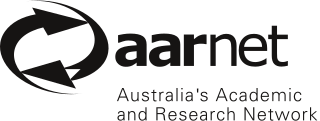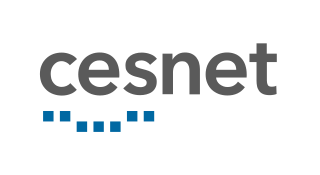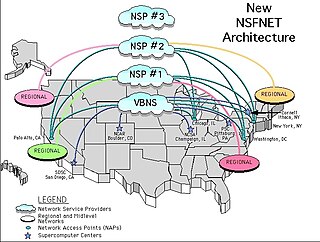
GÉANT is the pan-European data network for the research and education community. It interconnects national research and education networks (NRENs) across Europe, enabling collaboration on projects ranging from biological science, to earth observation, to arts and culture. The GÉANT project combines a high-bandwidth, high-capacity 50,000 km network with a growing range of services. These allow researchers to collaborate, working together wherever they are located. Services include identity and trust, multi-domain monitoring perfSONAR MDM, dynamic circuits and roaming via the eduroam service.

Janet is a high-speed network for the UK research and education community provided by Jisc, a not-for-profit company set up to provide computing support for education. It serves 18 million users and is the busiest National Research and Education Network in Europe by volume of data carried. Previously, Janet was a private, UK-government funded organisation, which provided the JANET computer network and related collaborative services to UK research and education.

Internet2 is a not-for-profit United States computer networking consortium led by members from the research and education communities, industry, and government. The Internet2 consortium administrative headquarters are located in Ann Arbor, Michigan, with offices in Washington, D.C., and Emeryville, California.
CARNET is the national research and education network of Croatia. It is funded from the government budget and it operates from offices in Zagreb and five other cities.

AARNet provides Internet services to the Australian education and research communities and their research partners.
RENATER is the national research and education network in France.

The Energy Sciences Network (ESnet) is a high-speed computer network serving United States Department of Energy (DOE) scientists and their collaborators worldwide. It is managed by staff at the Lawrence Berkeley National Laboratory.

CESNET is developer and operator of national e-infrastructure for science, research, development and education in Czech Republic. The CESNET association was founded in 1996 by Czech public universities and the Academy of Sciences of the Czech Republic. An important part of CESNET's activities is research of advanced network technologies and applications from hybrid networking, programmable hardware, metacomputing to middleware and video transmissions. CESNET fulfils the role of NREN within the Czech Republic and represents it in international organisations such as the GÉANT Association, EGI and GLIF. CESNET is involved in the implementation of the European backbone network project called GÉANT. Within the Czech Republic CESNET fulfils the role of a coordinator of large infrastructures involved in the field of information technology.

The very high-speed Backbone Network Service (vBNS) came on line in April 1995 as part of a National Science Foundation (NSF) sponsored project to provide high-speed interconnection between NSF-sponsored supercomputing centers and select access points in the United States. The network was engineered and operated by MCI Telecommunications under a cooperative agreement with the NSF.

SURF is an organization that develops, implements and maintains the national research and education network (NREN) of the Netherlands. It operates the national research network formally called SURFnet.

eduroam is an international Wi-Fi internet access roaming service for users in research, higher education and further education. It provides researchers, teachers, and students network access when visiting an institution other than their own. Users are authenticated with credentials from their home institution, regardless of the location of the eduroam access point. Authorization to access the Internet and other resources are handled by the visited institution. Users do not have to pay to use eduroam.
Delivery of Advanced Network Technology to Europe (DANTE) is a not-for-profit company that plans, builds and operates the consecutive generations of the backbone network that interconnects the national research and education networks (NRENs) in Europe. The organisation is based in Cambridge, United Kingdom and was formed in 1993 as a limited liability company owned by Réseaux Associés pour la Recherche Européenne (RARE). Ownership was transferred to a number of NRENs and government agencies in 1994.

Merit Network, Inc., is a nonprofit member-governed organization providing high-performance computer networking and related services to educational, government, health care, and nonprofit organizations, primarily in Michigan. Created in 1966, Merit operates the longest running regional computer network in the United States.
The Atlantic Canada Organization of Research Networks - Nova Scotia (ACORN-NS) operates an advanced research and education network in Nova Scotia, Canada.
The Academic Scientific Research Computer Network of Armenia (ASNET-AM) is the national research and education network (NREN) of Armenia. ASNET-AM was created in 1994. The structure and policy of ASNET-AM operation was developed and realized by the Institute for Informatics and Automation Problems of the National Academy of Sciences of Armenia.
Saskatchewan Research Network Incorporated (SRNET) is a research and education network providing networking service support education, research and innovation in the province of Saskatchewan, Canada. SRNET is member-driven and is a not-for-profit member of Canada's National Research and Education Network, which provides dedicated high speed network access to institutions and companies across Canada. SRNet also provides members access to CANARIE, a dedicated network that links similar research networks. The network also interconnects high performance computing resources within the province. SRNET's members link in to 112 international advanced networks in over 80 countries. Membership is open to all research, education and innovation organizations and institutions in Saskatchewan.

The Research and Educational Networking Association of Moldova (RENAM) is the national research and education networking organisation (NREN) of Moldova. RENAM was incorporated in June 1999 as an association under Moldovan law. It is a member of TERENA.

The Réseau d'informations scientifiques du Québec is the optical research and education network in the province of Quebec, Canada. The Risq is a non-profit cooperative established in 1989 by leaders from Quebec's universities, RISQ originally connected those universities to the U.S. government's NSFNET using leased telephone connections. It manages the education and research network in the Province of Quebec. This organisation offers telecommunication services to the Provincial universities and the Colleges of further education (CEGEP), the school boards, research institutes, university hospitals, government departments, agencies, cultural and service organizations.

Cybera is a not-for-profit corporation responsible for the operation of Alberta's Optical Regional Advanced Network. This network, known as CyberaNet, connects Alberta's research universities, colleges, K-12 schools, not-for-profits, and business incubators to one another and to the global grid of research and education networks using optical fibre. Cybera is funded by grants and its membership. The head office is located in the University of Calgary Research Park, with an additional office in downtown Edmonton.
Open educational resources in Canada are the various initiatives related to open education, open educational resources (OER), open pedagogies (OEP), open educational practices (OEP), and open scholarship that are established nationally and provincially across Canadian K-12 and higher education sectors, and where Canadian based inititatives extend to international collaborations.














